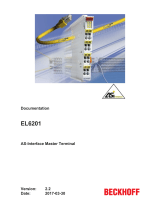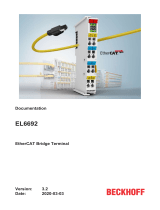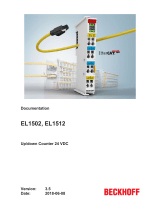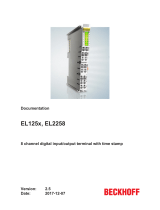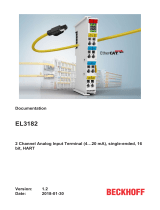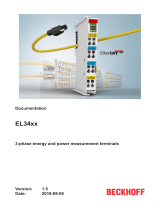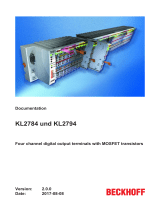Page is loading ...

Documentation
EK1110, EK1110-0008
EtherCAT Extension
2.
2017-05-29
Version:
Date:


Table of contents
EK1110, EK1110-0008 3Version: 2.
Table of contents
1 Foreword ....................................................................................................................................................5
1.1 Notes on the documentation........................................................................................................... 5
1.2 Safety instructions .......................................................................................................................... 6
1.3 Documentation issue status............................................................................................................ 7
1.4 Version identification of EtherCAT devices..................................................................................... 7
2 Product overview.....................................................................................................................................12
2.1 Introduction ................................................................................................................................... 12
2.2 Technical data .............................................................................................................................. 13
2.3 Start .............................................................................................................................................. 13
3 Basics communication ...........................................................................................................................14
3.1 System properties......................................................................................................................... 14
3.2 EtherCAT basics........................................................................................................................... 17
3.3 EtherCAT cabling – wire-bound.................................................................................................... 17
3.4 EtherCAT State Machine .............................................................................................................. 18
3.5 CoE - Interface: notes................................................................................................................... 19
3.6 Distributed Clock........................................................................................................................... 19
4 Mounting and wiring ...............................................................................................................................20
4.1 M8 Connector Cabling .................................................................................................................. 20
4.2 Nut torque for connectors ............................................................................................................. 22
4.3 Installation on mounting rails ........................................................................................................ 22
4.4 Installation instructions for enhanced mechanical load capacity .................................................. 25
4.5 Installation positions ..................................................................................................................... 26
4.6 Connection system ....................................................................................................................... 28
4.7 Mounting of Passive Terminals..................................................................................................... 31
4.8 ATEX - Special conditions (standard temperature range) ............................................................ 32
4.9 ATEX - Special conditions (extended temperature range) ........................................................... 33
4.10 ATEX Documentation ................................................................................................................... 34
4.11 UL notice....................................................................................................................................... 34
5 Commissioning........................................................................................................................................36
5.1 EK1110 - Configuration by means of the TwinCAT System Manager.......................................... 36
6 Error handling and diagnostics .............................................................................................................38
6.1 Diagnostic LED ............................................................................................................................. 38
7 Appendix ..................................................................................................................................................39
7.1 EtherCAT AL Status Codes .......................................................................................................... 39
7.2 Firmware compatibility .................................................................................................................. 39
7.3 Firmware Update EL/ES/EM/EPxxxx............................................................................................ 39
7.4 Support and Service ..................................................................................................................... 49

Table of contents
EK1110, EK1110-00084 Version: 2.

Foreword
EK1110, EK1110-0008 5Version: 2.
1 Foreword
1.1 Notes on the documentation
Intended audience
This description is only intended for the use of trained specialists in control and automation engineering who
are familiar with the applicable national standards.
It is essential that the documentation and the following notes and explanations are followed when installing
and commissioning these components.
It is the duty of the technical personnel to use the documentation published at the respective time of each
installation and commissioning.
The responsible staff must ensure that the application or use of the products described satisfy all the
requirements for safety, including all the relevant laws, regulations, guidelines and standards.
Disclaimer
The documentation has been prepared with care. The products described are, however, constantly under
development.
We reserve the right to revise and change the documentation at any time and without prior announcement.
No claims for the modification of products that have already been supplied may be made on the basis of the
data, diagrams and descriptions in this documentation.
Trademarks
Beckhoff
®
, TwinCAT
®
, EtherCAT
®
, Safety over EtherCAT
®
, TwinSAFE
®
, XFC
®
and XTS
®
are registered
trademarks of and licensed by Beckhoff Automation GmbH.
Other designations used in this publication may be trademarks whose use by third parties for their own
purposes could violate the rights of the owners.
Patent Pending
The EtherCAT Technology is covered, including but not limited to the following patent applications and
patents: EP1590927, EP1789857, DE102004044764, DE102007017835 with corresponding applications or
registrations in various other countries.
The TwinCAT Technology is covered, including but not limited to the following patent applications and
patents: EP0851348, US6167425 with corresponding applications or registrations in various other countries.
EtherCAT
®
is registered trademark and patented technology, licensed by Beckhoff Automation GmbH,
Germany
Copyright
© Beckhoff Automation GmbH & Co. KG, Germany.
The reproduction, distribution and utilization of this document as well as the communication of its contents to
others without express authorization are prohibited.
Offenders will be held liable for the payment of damages. All rights reserved in the event of the grant of a
patent, utility model or design.

Foreword
EK1110, EK1110-00086 Version: 2.
1.2 Safety instructions
Safety regulations
Please note the following safety instructions and explanations!
Product-specific safety instructions can be found on following pages or in the areas mounting, wiring,
commissioning etc.
Exclusion of liability
All the components are supplied in particular hardware and software configurations appropriate for the
application. Modifications to hardware or software configurations other than those described in the
documentation are not permitted, and nullify the liability of Beckhoff Automation GmbH & Co. KG.
Personnel qualification
This description is only intended for trained specialists in control, automation and drive engineering who are
familiar with the applicable national standards.
Description of symbols
In this documentation the following symbols are used with an accompanying safety instruction or note. The
safety instructions must be read carefully and followed without fail!
DANGER
Serious risk of injury!
Failure to follow the safety instructions associated with this symbol directly endangers the
life and health of persons.
WARNING
Risk of injury!
Failure to follow the safety instructions associated with this symbol endangers the life and
health of persons.
CAUTION
Personal injuries!
Failure to follow the safety instructions associated with this symbol can lead to injuries to
persons.
Attention
Damage to the environment or devices
Failure to follow the instructions associated with this symbol can lead to damage to the en-
vironment or equipment.
Note
Tip or pointer
This symbol indicates information that contributes to better understanding.

Foreword
EK1110, EK1110-0008 7Version: 2.
1.3 Documentation issue status
Version Modifications
2.2 - Technical data added
- Update structure
2.1 - Addenda of EK1110-0008
2.0 - Migration
1.4 - Technical data added
- Addenda chapter "Installation instructions for enhanced mechanical load capacity"
1.3 - Technical data added
- Update structure
1.2 - Technical data added
1.1 - Technical data adapted
1.0 - Technical data added
0.1 - First preliminary version
1.4 Version identification of EtherCAT devices
Designation
A Beckhoff EtherCAT device has a 14-digit designation, made up of
• family key
• type
• version
• revision
Example Family Type Version Revision
EL3314-0000-0016 EL terminal
(12 mm, non-
pluggable connection
level)
3314 (4-channel thermocouple
terminal)
0000 (basic type) 0016
ES3602-0010-0017 ES terminal
(12 mm, pluggable
connection level)
3602 (2-channel voltage
measurement)
0010 (high-
precision version)
0017
CU2008-0000-0000 CU device 2008 (8-port fast ethernet switch) 0000 (basic type) 0000
Notes
• The elements mentioned above result in the technical designation. EL3314-0000-0016 is used in the
example below.
• EL3314-0000 is the order identifier, in the case of “-0000” usually abbreviated to EL3314. “-0016” is the
EtherCAT revision.
• The order identifier is made up of
- family key (EL, EP, CU, ES, KL, CX, etc.)
- type (3314)
- version (-0000)
• The revision -0016 shows the technical progress, such as the extension of features with regard to the
EtherCAT communication, and is managed by Beckhoff.
In principle, a device with a higher revision can replace a device with a lower revision, unless specified
otherwise, e.g. in the documentation.
Associated and synonymous with each revision there is usually a description (ESI, EtherCAT Slave
Information) in the form of an XML file, which is available for download from the Beckhoff web site.
From 2014/01 the revision is shown on the outside of the IP20 terminals, see Fig. “EL5021 EL terminal,
standard IP20 IO device with batch number and revision ID (since 2014/01)”.

Foreword
EK1110, EK1110-00088 Version: 2.
• The type, version and revision are read as decimal numbers, even if they are technically saved in
hexadecimal.
Identification number
Beckhoff EtherCAT devices from the different lines have different kinds of identification numbers:
Production lot/batch number/serial number/date code/D number
The serial number for Beckhoff IO devices is usually the 8-digit number printed on the device or on a sticker.
The serial number indicates the configuration in delivery state and therefore refers to a whole production
batch, without distinguishing the individual modules of a batch.
Structure of the serial number: KKYYFFHH
KK - week of production (CW, calendar week)
YY - year of production
FF - firmware version
HH - hardware version
Example with
Ser. no.: 12063A02: 12 - production week 12 06 - production year 2006 3A - firmware version 3A 02 -
hardware version 02
Exceptions can occur in the IP67 area, where the following syntax can be used (see respective device
documentation):
Syntax: D ww yy x y z u
D - prefix designation
ww - calendar week
yy - year
x - firmware version of the bus PCB
y - hardware version of the bus PCB
z - firmware version of the I/O PCB
u - hardware version of the I/O PCB
Example: D.22081501 calendar week 22 of the year 2008 firmware version of bus PCB: 1 hardware version
of bus PCB: 5 firmware version of I/O PCB: 0 (no firmware necessary for this PCB) hardware version of I/O
PCB: 1
Unique serial number/ID, ID number
In addition, in some series each individual module has its own unique serial number.
See also the further documentation in the area
• IP67: EtherCAT Box
• Safety: TwinSafe
• Terminals with factory calibration certificate and other measuring terminals

Foreword
EK1110, EK1110-0008 9Version: 2.
Examples of markings
Fig.1: EL5021 EL terminal, standard IP20 IO device with batch number and revision ID (since 2014/01)
Fig.2: EK1100 EtherCAT coupler, standard IP20 IO device with batch number
Fig.3: CU2016 switch with batch number

Foreword
EK1110, EK1110-000810 Version: 2.
Fig.4: EL3202-0020 with batch numbers 26131006 and unique ID-number 204418
Fig.5: EP1258-00001 IP67 EtherCAT Box with batch number 22090101 and unique serial number 158102
Fig.6: EP1908-0002 IP67 EtherCAT Safety Box with batch number 071201FF and unique serial number
00346070
Fig.7: EL2904 IP20 safety terminal with batch number/date code 50110302 and unique serial number
00331701

Foreword
EK1110, EK1110-0008 11Version: 2.
Fig.8: ELM3604-0002 terminal with ID number (QR code) 100001051 and unique serial number 44160201

Product overview
EK1110, EK1110-000812 Version: 2.
2 Product overview
2.1 Introduction
EK1110/ EK1110-0008 EtherCAT extension
Fig.9: EK1110/ EK1110-0008
Like the E-bus end terminal, the EK1110 and accordingly the EK1110-0008 EtherCAT extension is
connected to the end of the EtherCAT Terminal Block. The terminal offers the option of connecting an
Ethernet cable with RJ 45 or rather M8 connector, thereby extending the EtherCAT strand electrically
isolated by up to 100 m. In the EK1110 (EK1110-0008) terminal, the E-bus signals are converted on the fly
to 100BASE-TX Ethernet signal representation. Power supply of both terminals to the electronics is via the
E-bus. No parameterization or configuration tasks are required.
The M8 socket of the type EK1110-0008 is compatible with the EtherCAT Box modules. If Ethernet cables
with adequate performance are used, e.g. ZK1090-3131-1xxx, line lengths of 100 m are possible via M8.
Connection
Terminal point Description Type
Designation EK1110 EK1110-0008
X1 Connection for EtherCAT networks (100BASE-
TX Ethernet signal representation)
RJ45 M8

Product overview
EK1110, EK1110-0008 13Version: 2.
2.2 Technical data
Technical data EK1110 EK1110-0008
Task in the EtherCAT system Conversion of the E-bus signals to 100BASE-TX Ethernet for extension
of the EtherCAT network
Transmission medium Ethernet CAT 5 cable (shielded)
Cable length between two Bus
Couplers
max. 100 m (100BASE-TX)
Protocol / Baud rate any EtherCAT protocol / 100Mbaud
Delay approx. 1 µs
Configuration no address and configuration settings required
Bus connection 1 x RJ45 1 x M8, shielded, screw type
Power supply from E-bus
Current consumption typ. 130 mA
Dielectric strength 500 V (supply voltage/EtherCAT)
Dimensions (W x H x D) approx. 44 mm x 100 mm x 68 mm
Weight approx. 50 g
Permissible ambient temperature
range during operation
-25°C ... +60°C
(extended temperature range)
0°C ... +55°C
Permissible ambient temperature
range during storage
-40°C ... + 85°C -25°C ... + 85°C
Permissible relative humidity 95%, no condensation
Mounting [}22]
on 35 mm mounting rail conforms to EN 60715
Vibration/shock resistance conforms to EN 60068-2-6 / EN
60068-2-27,
see also installation instructions
[}25] for enhanced mechanical
load capacity
conforms to EN 60068-2-6 / EN
60068-2-27
EMC immunity/emission conforms to EN 61000-6-2 / EN 61000-6-4
Protection class IP20
Installation position variable
Approval CE
ATEX [}33]
cULus [}34]
CE
ATEX [}32]
cULus [}34]
2.3 Start
For commissioning:
• mount the EK1110 as described in the chapter Mounting and wiring [}20]
• configure the EK1110 in TwinCAT as described in chapter Parameterization and commissioning
[}36].

Basics communication
EK1110, EK1110-000814 Version: 2.
3 Basics communication
3.1 System properties
Protocol
The EtherCAT protocol is optimized for process data and is transported directly within the Ethernet frame
thanks to a special Ether-type. It may consist of several sub-telegrams, each serving a particular memory
area of the logical process images that can be up to 4 gigabytes in size. The data sequence is independent
of the physical order of the Ethernet terminals in the network; addressing can be in any order. Broadcast,
Multicast and communication between slaves are possible. Transfer directly in the Ethernet frame is used in
cases where EtherCAT components are operated in the same subnet as the control computer.
However, EtherCAT applications are not limited to a subnet: EtherCAT UDP packs the EtherCAT protocol
into UDP/IP datagrams. This enables any control with Ethernet protocol stack to address EtherCAT systems.
Even communication across routers into other subnets is possible. In this variant, system performance
obviously depends on the real-time characteristics of the control and its Ethernet protocol implementation.
The response times of the EtherCAT network itself are hardly restricted at all: the UDP datagram only has to
be unpacked in the first station.
Fig.10: EtherCAT Telegram Structure
Protocol structure: The process image allocation is freely configurable. Data are copied directly in the I/O
terminal to the desired location within the process image: no additional mapping is required. The available
logical address space is with very large (4 GB).

Basics communication
EK1110, EK1110-0008 15Version: 2.
Topology
Line, tree or star: EtherCAT supports almost any topology. The bus or line structure known from the
fieldbuses thus also becomes available for Ethernet. Particularly useful for system wiring is the combination
of line and junctions or stubs. The required interfaces exist on the couplers; no additional switches are
required. Naturally, the classic switch-based Ethernet star topology can also be used.
Fig.11: EtherCAT Topology
Maximum wiring flexibility:
with or without switch, line or tree topologies, can be freely selected and combined.
Wiring flexibility is further maximized through the choice of different cables. Flexible and cost-effective
standard Ethernet patch cables transfer the signals in Ethernet mode (100Base-TX). The complete
bandwidth of the Ethernet network - such as different optical fibers and copper cables - can be used in
combination with switches or media converters.
Distributed Clocks
Accurate synchronization is particularly important in cases where spatially distributed processes require
simultaneous actions. This may be the case, for example, in applications where several servo axes carry out
coordinated movements simultaneously.
The most powerful approach for synchronization is the accurate alignment of distributed clocks, as described
in the new IEEE 1588 standard. In contrast to fully synchronous communication, where synchronization
quality suffers immediately in the event of a communication fault, distributed aligned clocks have a high
degree of tolerance vis-à-vis possible fault-related delays within the communication system.

Basics communication
EK1110, EK1110-000816 Version: 2.
With EtherCAT, the data exchange is fully based on a pure hardware machine. Since the communication
utilizes a logical (and thanks to full-duplex Fast Ethernet also physical) ring structure, the mother clock can
determine the run-time offset to the individual daughter clocks simply and accurately - and vice versa. The
distributed clocks are adjusted based on this value, which means that a very precise network-wide timebase
with a jitter of significantly less than 1 microsecond is available.
However, high-resolution distributed clocks are not only used for synchronization, but can also provide
accurate information about the local timing of the data acquisition. For example, controls frequently calculate
velocities from sequentially measured positions. Particularly with very short sampling times, even a small
temporal jitter in the displacement measurement leads to large step changes in velocity. With EtherCAT new,
extended data types are introduced as a logical extension (time stamp and oversampling data type). The
local time is linked to the measured value with a resolution of up to 10 ns, which is made possible by the
large bandwidth offered by Ethernet. The accuracy of a velocity calculation then no longer depends on the
jitter of the communication system. It is orders of magnitude better than that of measuring techniques based
on jitter-free communication.
Performance
EtherCAT reaches new dimensions in network performance. Protocol processing is purely hardware-based
through an FMMU chip in the terminal and DMA access to the network card of the master. It is thus
independent of protocol stack run-times, CPU performance and software implementation. The update time
for 1000 I/Os is only 30 µs - including terminal cycle time. Up to 1486 bytes of process data can be
exchanged with a single Ethernet frame - this is equivalent to almost 12000 digital inputs and outputs. The
transfer of this data quantity only takes 300 µs.
The communication with 100 servo axes only takes 100 µs. During this time, all axes are provided with set
values and control data and report their actual position and status. Distributed clocks enable the axes to be
synchronized with a deviation of significantly less than 1 microsecond.
The extremely high performance of the EtherCAT technology enables control concepts that could not be
realized with classic fieldbus systems. For example, the Ethernet system can now not only deal with velocity
control, but also with the current control of distributed drives. The tremendous bandwidth enables status
information to be transferred with each data item. With EtherCAT, a communication technology is available
that matches the superior computing power of modern Industrial PCs. The bus system is no longer the
bottleneck of the control concept. Distributed I/Os are recorded faster than is possible with most local I/O
interfaces. The EtherCAT technology principle is scalable and not bound to the baud rate of 100 Mbaud –
extension to Gbit Ethernet is possible.
Diagnostics
Experience with fieldbus systems shows that availability and commissioning times crucially depend on the
diagnostic capability. Only faults that are detected quickly and accurately and which can be precisely located
can be corrected quickly. Therefore, special attention was paid to exemplary diagnostic features during the
development of EtherCAT.
During commissioning, the actual configuration of the I/O terminals should be checked for consistency with
the specified configuration. The topology should also match the saved configuration. Due to the built-in
topology recognition down to the individual terminals, this verification can not only take place during system
start-up, automatic reading in of the network is also possible (configuration upload).
Bit faults during the transfer are reliably detected through evaluation of the CRC checksum: The 32 bit CRC
polynomial has a minimum hamming distance of 4. Apart from breaking point detection and localization, the
protocol, physical transfer behavior and topology of the EtherCAT system enable individual quality
monitoring of each individual transmission segment. The automatic evaluation of the associated error
counters enables precise localization of critical network sections. Gradual or changing sources of error such
as EMC influences, defective push-in connectors or cable damage are detected and located, even if they do
not yet overstrain the self-healing capacity of the network.
Integration of standard Bus Terminals from Beckhoff
In addition to the new Bus Terminals with E-Bus connection (ELxxxx), all Bus Terminals from the familiar
standard range with K-bus connection (KLxxxx) can be connected via the BK1120 or BK1250 Bus Coupler.
This ensures compatibility and continuity with the existing Beckhoff Bus Terminal systems. Existing
investments are protected.

Basics communication
EK1110, EK1110-0008 17Version: 2.
3.2 EtherCAT basics
Please refer to the chapter EtherCAT System Documentation for the EtherCAT fieldbus basics.
3.3 EtherCAT cabling – wire-bound
The cable length between two EtherCAT devices must not exceed 100 m. This results from the FastEthernet
technology, which, above all for reasons of signal attenuation over the length of the cable, allows a maximum
link length of 5 + 90 + 5 m if cables with appropriate properties are used. See also the Design
recommendations for the infrastructure for EtherCAT/Ethernet.
Cables and connectors
For connecting EtherCAT devices only Ethernet connections (cables + plugs) that meet the requirements of
at least category 5 (CAt5) according to EN 50173 or ISO/IEC 11801 should be used. EtherCAT uses 4 wires
for signal transfer.
EtherCAT uses RJ45 plug connectors, for example. The pin assignment is compatible with the Ethernet
standard (ISO/IEC 8802-3).
Pin Color of conductor Signal Description
1 yellow TD + Transmission Data +
2 orange TD - Transmission Data -
3 white RD + Receiver Data +
6 blue RD - Receiver Data -
Due to automatic cable detection (auto-crossing) symmetric (1:1) or cross-over cables can be used between
EtherCAT devices from Beckhoff.
Note
Recommended cables
Suitable cables for the connection of EtherCAT devices can be found on the Beckhoff web-
site!
E-Bus supply
A bus coupler can supply the EL terminals added to it with the E-bus system voltage of 5V; a coupler is
thereby loadable up to 2A as a rule (see details in respective device documentation).
Information on how much current each EL terminal requires from the E-bus supply is available online and in
the catalogue. If the added terminals require more current than the coupler can supply, then power feed
terminals (e.g. EL9410) must be inserted at appropriate places in the terminal strand.
The pre-calculated theoretical maximum E-Bus current is displayed in the TwinCAT System Manager. A
shortfall is marked by a negative total amount and an exclamation mark; a power feed terminal is to be
placed before such a position.
Fig.12: System manager current calculation

Basics communication
EK1110, EK1110-000818 Version: 2.
Attention
Malfunction possible!
The same ground potential must be used for the E-Bus supply of all EtherCAT terminals in
a terminal block!
3.4 EtherCAT State Machine
The state of the EtherCAT slave is controlled via the EtherCAT State Machine (ESM). Depending upon the
state, different functions are accessible or executable in the EtherCAT slave. Specific commands must be
sent by the EtherCAT master to the device in each state, particularly during the bootup of the slave.
A distinction is made between the following states:
• Init
• Pre-Operational
• Safe-Operational and
• Operational
• Boot
The regular state of each EtherCAT slave after bootup is the OP state.
Fig.13: States of the EtherCAT State Machine
Init
After switch-on the EtherCAT slave in the Init state. No mailbox or process data communication is possible.
The EtherCAT master initializes sync manager channels 0 and 1 for mailbox communication.
Pre-Operational (Pre-Op)
During the transition between Init and Pre-Op the EtherCAT slave checks whether the mailbox was initialized
correctly.
In Pre-Op state mailbox communication is possible, but not process data communication. The EtherCAT
master initializes the sync manager channels for process data (from sync manager channel 2), the FMMU
channels and, if the slave supports configurable mapping, PDO mapping or the sync manager PDO
assignment. In this state the settings for the process data transfer and perhaps terminal-specific parameters
that may differ from the default settings are also transferred.

Basics communication
EK1110, EK1110-0008 19Version: 2.
Safe-Operational (Safe-Op)
During transition between Pre-Op and Safe-Op the EtherCAT slave checks whether the sync manager
channels for process data communication and, if required, the distributed clocks settings are correct. Before
it acknowledges the change of state, the EtherCAT slave copies current input data into the associated DP-
RAM areas of the EtherCAT slave controller (ECSC).
In Safe-Op state mailbox and process data communication is possible, although the slave keeps its outputs
in a safe state, while the input data are updated cyclically.
Note
Outputs in SAFEOP state
The default set watchdog monitoring sets the outputs of the module in a safe state - de-
pending on the settings in SAFEOP and OP - e.g. in OFF state. If this is prevented by de-
activation of the watchdog monitoring in the module, the outputs can be switched or set
also in the SAFEOP state.
Operational (Op)
Before the EtherCAT master switches the EtherCAT slave from Safe-Op to Op it must transfer valid output
data.
In the Op state the slave copies the output data of the masters to its outputs. Process data and mailbox
communication is possible.
Boot
In the Boot state the slave firmware can be updated. The Boot state can only be reached via the Init state.
In the Boot state mailbox communication via the file access over EtherCAT (FoE) protocol is possible, but no
other mailbox communication and no process data communication.
3.5 CoE - Interface: notes
This device has no CoE.
Detailed information on the CoE interface can be found in the EtherCAT system documentation on the
Beckhoff website.
3.6 Distributed Clock
The distributed clock represents a local clock in the EtherCAT slave controller (ESC) with the following
characteristics:
• Unit 1 ns
• Zero point 1.1.2000 00:00
• Size 64 bit (sufficient for the next 584 years; however, some EtherCAT slaves only offer 32-bit support,
i.e. the variable overflows after approx. 4.2 seconds)
• The EtherCAT master automatically synchronizes the local clock with the master clock in the EtherCAT
bus with a precision of < 100 ns.
For detailed information please refer to the EtherCAT system description.

Mounting and wiring
EK1110, EK1110-000820 Version: 2.
4 Mounting and wiring
4.1 M8 Connector Cabling
A list of the EtherCAT cable, power cable, sensor cable, Ethernet-/EtherCAT connectors and the field
assembled connectors can be found at the following link: http://download.beckhoff.com/download/
document/catalog/main_catalog/english/Beckhoff_EtherCAT-Box-Accessories.pdf
You can find the corresponding data sheets at the following link: http://beckhoff.de/english/fieldbus_box/
data_sheets.htm?id=69033899254355
EtherCAT cable
Fig.14: ZK1090-3131-0xxx
For connecting EtherCAT devices only shielded Ethernet cables that meet the requirements of at least
category 5 (CAT5) according to EN 50173 or ISO/IEC 11801 should be used.
Note
Recommendations about cabling
You may get detailed recommendations about cabling EtherCAT from the documentation
"Recommendations for the design of the infrastructure for EtherCAT/Ethernet", that is avail-
able for download at www.Beckhoff.com.
EtherCAT uses 4 wires for signal transfer.
Due to automatic cable detection (auto-crossing) symmetric (1:1) or cross-over cables can be used between
EtherCAT devices from Beckhoff.
/
